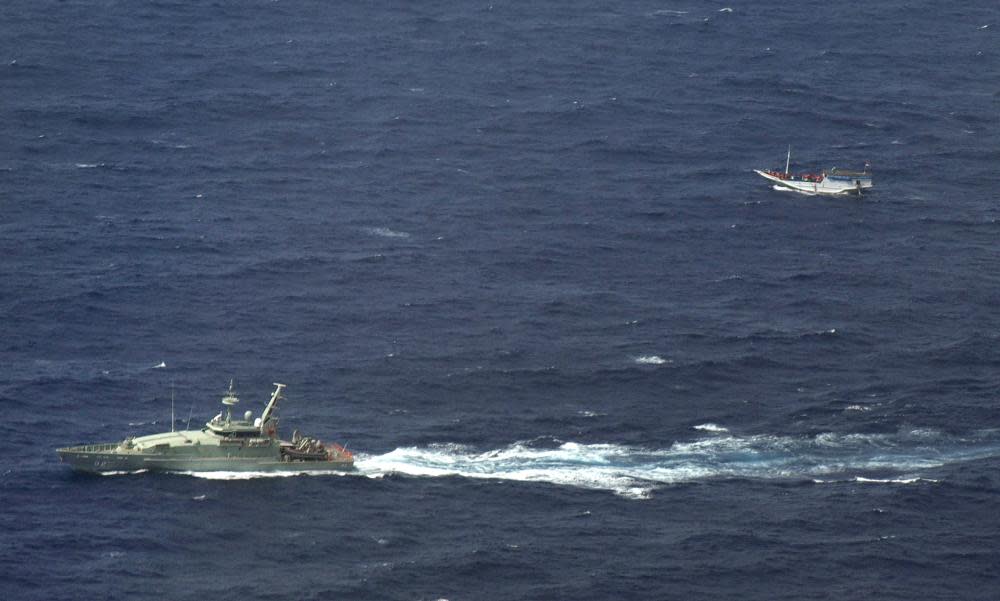Almost 300 asylum seekers prevented from sailing to Australia in past year

International authorities, with the assistance of Australia, have “disrupted” at least 10 alleged attempts to transport almost 300 asylum seekers to Australia by boat in the past 14 months, documents obtained under freedom of information reveal.
The documents, from the federal home affairs department, record the number of “foreign law enforcement agency” (FLEA) disruptions since 2013.
FLEA disruptions were set up as one of three components of the Abbott government’s border policy – alongside boat turnbacks and offshore detention and processing.
Since the establishment of the new policy there have been 78 disruption operations involving 2,525 “potential illegal immigrants” – the terms used in the documents referencing suspected passengers.
In the year to August there were 10 disruptions involving 297 people, the majority occurring in Indonesia but also in Sri Lanka and Malaysia.
FLEA disruptions are operated by a multi-agency taskforce led by Australian federal police and reporting to the head of Australia’s border enforcement operation, air vice marshal Stephen Osborne, and seek to prevent vessels carrying asylum seekers from leaving international ports including Indonesia.
The taskforce has stationed more than a dozen extra liaison officers in various countries, on top of almost 100 already there, targeting known transport hubs, Guardian Australia understands.
The operations involved weeks or months of intelligence gathering on individual plans for people-smuggling ventures, before local authorities intercepted groups – usually just prior to the point of departure.
The freedom of information documents note 614 arrests since September 2013, as well as 14 arrest warrants.
Most arrests – 489 – occurred in Sri Lanka, followed by 48 in Malaysia and 66 in Indonesia. Thirteen of the 14 arrest warrants were issued in Indonesia.
However the document notes the statistics are “indicative only” as they were provided by AFP posts from advice given by foreign law enforcement.
“Post experience is that results are typically under-reported because arrests in regional locations are occasionally not reported.”
Asher Hirsch, senior policy advisor with the Refugee Council of Australia, said the fact Australia was still working with Indonesian authorities to stop asylum seekers getting on boats “highlights the desperation of people there”.
“Refugees in Indonesia have no basic rights and are living in indefinite limbo and uncertainty. Instead of interceptions and disruptions of potential boat journeys, the Australian government should work with the Indonesian government to ensure refugees have the right to work, education and healthcare, and can remain in Indonesia safely until they find another solution,” Hirsch said.
“A better way to spend this money would be to invest in helping refugees in Indonesia through local initiatives and increasing our resettlement program to share responsibility for refugee protection.”
Indonesia is not a signatory to the UN refugee convention and has no status determination system of its own, and so asylum claims are assessed by the UNHCR.
As of December last year Indonesia was hosting around 13,800 refugees from 49 countries. About half originated from Afghanistan. At least 800 more have arrived in 2018.
The International Organisation for Migration has provided basic healthcare and shelter for around two-thirds of the refugee and asylum seeker population in Indonesia since 2000, under a regional cooperation arrangement between the organisation, Indonesia and Australia.
However in March the Australian government announced it was cutting funding to the IOM, saying it did not want Indonesia to be a “pull factor” for asylum seekers.
In 2017 only 763 people were resettled in a third country from Indonesia, more than half in Australia, according to the Refugee Council of Australia. The US settled 228, but has since cut its resettlement program from more than 96,000 to 30,000.
The IOM also administered the Australia-funded Assisted Voluntary Returns program, offering asylum seekers $2,000 plus airfares to return to their country of origin.
The Australian government refuses to resettle any refugee who arrives in Australia by boat.
Under the other two arms of Operation Sovereign Borders, Australian customs and authorities intercept and return vessels to their point of origin, “when it is safe to do so”, and have in the past commissioned replica Asian fishing vessels to put passengers on when their own vessel is unsafe. Australia was previously using orange lifeboats to do this.
Offshore processing has seen thousands of men, women and children held in detention centres on Christmas Island, Papua New Guinea’s Manus Island, and Nauru, in many cases for longer than five years.
The minister for home affairs, Peter Dutton, did not respond to requests for comment.

 Yahoo News
Yahoo News 
